el es frida kahlo will be on view at the Bruno David Gallery in St. Louis, MO from 1/22-3/6. In conjunction with the exhibition, I am offering a FREE embeddable animated el es frida kahlo gif on mayaescobar.com.

el es frida kahlo will be on view at the Bruno David Gallery in St. Louis, MO from 1/22-3/6. In conjunction with the exhibition, I am offering a FREE embeddable animated el es frida kahlo gif on mayaescobar.com.

Here are some behind the scenes images from the many Acciones Plásticas プリクラ photo shoots.
The Latina Hipster
The Homegirl
The Homegirl putting on fake nails (lovin' the shabbos candlesticks and theory books in the background)
The Avodah Girl
The 612er
---------------------------------------------------------
Check out this inspiring write-up on Acciones Plásticas プリクラ on Truth and Healing Project.excerpt below:
goodness. I’ve been thinking a lot about the intersections between new media and traditional forms of knowledge and how these intersections can be ways of supporting tradition, innovation, resistance and liberation. As a media-maker, I’ve thought a lot about non-traditional forms of telling stories and the value of stories to allow us as individuals and communities to grow and remain in movement. I want to both honor our traditions and create space for challenge in order to support growth. This is particularly challenging when, as indigenos, we are usually FORCED into the frozen stance (as my sister Whisper says) of the “American Imaginary”. Born out of a flat analysis, the “American Imaginary” boxes us into specific archetypes and narratives that, though perhaps grounded in truth, metaphorically and at times literally “freeze” us and immobilize us from engaging in healthy movement and LIFE. As a guatemalan-born/ mixed -id’d/ mayan-adoptee I’ve dreamed about new and innovative ways to create forums and craft form that embodies the intersections of say, mayan id, transracial queer, working class, single teen mama id. For example, as a queerasfuck femme I’ve LITERALLY dreamed of beginning a series of corsets created out of huipil’s with stories attached to each… though I have yet to begin work on that. I am so excited by the thoughts of spaces for dialogue, beauty, challenge & examination of the COMPLEX identities embodies by the our contemporary indigena communities. . Fierce and phenomenal chicana and radical latina artists have had HUGE impacts on me but I’ve been hungry to see this come from other guatemelan/ mayan artists. Today, I got a taste of a contemporary and GUATEMALAN artist who is actively engaged in a similar examination! I came across this blog (and art work) and it was as if an answer was given to me in the form of possibilities. A sweet affirmation that this form of mayan/guatemalan art CAN and DOES exist.
a guest post by seeNoga.
As you doggedly pursue, chase, and snap at the heels of your Self, you do so knowing there is no chance you will ever catch up. For each of us, throughout our individual lives, we will be ever distant from knowing our own selves. When a person pursues his or her Self in an aggressive, determined way, the resulting hyperactive sensibility allows for a greater adaptability and sensitivity. This flexibility can be useful in contemporary human life, but only to a certain extent. It is also due to the fast-paced nature of today’s engineered environments, that there is a strong tendency (especially among young people) to go to extreme lengths in order to sustain within their own lives the hyperactivity and intensity they witness in popular culture and media. Consider the called-for constant reachability via cell-phones and laptops, as well as many other forms of expedition in our ‘lived-in’ world. These accommodations range from aerodynamics to ATMs. As many workers in today’s professional world simultaneously lament and extol their parasitic relationships with a Blackberry or other such Pocket God, I, too, have at many times felt chained to my laptop (i.e. the Internet), fearing I would miss something absolutely critical. Unfortunately, the fact that missing anything important has not happened for the most part, hardly affects the worry and anxiety that it might happen.Yet still, it seems, this once motivating anxiety is becoming a repressed urge, one which is less and less a bother, the more my environment becomes one seamless, semi-omniscient “news” feed. On the evening of President Barack Obama’s Address to the Nation, Maya Escobar recorded “Obama Tweet: How a New Generation Gets Their Information.” In this video Escobar documented a particular event, an important cultural event, one which incidentally brought the use of Twitter to the fore in popular culture.[youtube= http://www.youtube.com/watch?v=359HwupsY1s]
Obama Tweet: How a New Generation Gets Their Information, 2008
I was with Escobar on this evening and was struck by the depth of her interaction with the digital realm. She was sitting in front of a T.V. broadcast of the speech, while she was also further mediating that media via her computer, on which she was following Twitter and CNN.com’s coverage of the event. Beyond all that, Escobar was creating her own real-time, indexical document of the event on television along with CNN and Twitter as instantaneous forms of annotations to the President's speech. Escobar was watching, sitting one more stage removed, behind the lens of a video camera. Because of the way in which she layered the television screen the computer screen and then the interface of any viewer's monitor, Escobar has effortlessly choreographed a multi-layered, engagement with the very most current of events. However, though I may have somewhat qualified and rationalized instant-communication tools, I still believe there must be a deliberate effort to complement those socially-prescribed media with other, independent forms of digital exchanges. While I do believe in the great social potential of our rapidly advancing communications media, my work seeks to push and pull on parts of these evolving global ‘informachines,’ in an effort to challenge the omnipresence of commercial media.[youtube=http://www.youtube.com/watch?v=d0ZvYQOp89I]
Look Out, 2008
That sort of layering of non-dimensional spaces is unique to the contemporary world, with the inception of digital technologies, and this collage-like aesthetic is of great interest to the work of Maya Escobar, as much as it is to my own. Although, unlike the deceptively referential works of my counter-part, in many of my works, I use and refer to popular media sources and specific Internet sites indirectly and rarely with any superficial visibility. It is with great deliberation and much hypothesizing that I curate my works in the manner in which I do. I intend my works to avoid specificity and leave wide-open their readings to a much more self-guided analysis by viewers. In the piece “Look Out,” the projected video came directly from YouTube. I simply cut off the last second of the original video, thus shortening it to 17 seconds. I then prepared it as a video-loop for its installation underneath a staircase at the Mildred Lane Kemper Art Museum. Because of its placement, where it fills a theretofore, unaddressed space, it is as though the rolling image is part of the museum structure itself. The particular clip, which I chose after viewing dozens of similarly tagged videos (‘storm,’ ‘tree,’ ‘willow,’ and ‘weeping’), was selected for very specific compositional reasons; reasons which are the very same principles of design taught to anyone working in commercial design or the visual arts: complimentary colors, rule of thirds, dynamic composition and varied textures, to name a few. Because of my focused selection process, this video, although created for very different (and unknown) reasons, still fits very well into the installation space as a deliberately designed, and potentially permanent use of what is otherwise a neglected space. The video became part of the stairwell. By existing within a predetermined, architectural frame, it became part of the space, as opposed to sitting on the surface as a painting does. This projection did not exist in the way that many (most) installations do: as obvious alterations or obtrusive interjections into a space. This work asserts itself as a physical part of the space, as the projector beams through from behind the scrim in the stairwell. It also assumes a living presence, as it reiterates itself, by many reflections and refractions, split and scattered, bouncing around the main hall of the museum. The video functioned as a decorative element but also an illusory window to an outside world, whereas, the space without that piece is simply a pane of glass that looks into the shadowy crotch of a stairwell. I do not mean every square inch should be taken up for some sort of visual activity or illusionary window. Simply, this work proposes how our constructed spaces, in this case a venue for art viewing, might be reinterpreted. Insofar as, a corner can conceivably become a window, as illusory and impermanent as my particular interpretation may be.
*NOESCO is seeNoga and maya escobar
Darja sent me a beautiful email on YouTube earlier this week. Needless to say, I was quite taken by her.
[youtube=http://www.youtube.com/watch?v=SuZtuDZjvQE][youtube=http://www.youtube.com/watch?v=6hY2_e-HWYI][vimeo=http://vimeo.com/3465404][vimeo=http://vimeo.com/3064268]

from obsessed with frida kahlo
[youtube=http://www.youtube.com/watch?v=_RrS5xvfRXg]
no sos frida kahlo, 2007
[youtube=http://www.youtube.com/watch?v=dsHCjxKoYc4]
puppets, 2007

My newest partner in crime is the talented, witty, godzilla and pikapika lovin' Chicano artist and curator Rio Yañez. I first came across his Ghetto Frida two years ago, while working on the project Obsessed With Frida Kahlo. Immediately I felt some sort of cosmic connection-not to Ghetto Frida- but to her creator. And then to make matters worse better, I found out that he is the son of one my biggest heroes- Yolanda Lopez!There was really no option other than collaboration. It was fate.Last month we finally initiated our long distance partnership through a tweet. Since then we have been communicating through TwitPic, Facebook, YouTube, phone calls and texts, and of course mutual shouts in interviews on the blogosphere (mine to Rio & Rio's to me.)Here are a few examples of Rio's recent work:
"I’ve been twittering for about a week now at http://twitter.com/rioyanez. I signed up as a way to contact Amber Rose after she started writing and posting about the portrait I created of her. I have to say, the most exciting aspect of twitter is the way people distribute images. The short urls for twitpics that often pop up on tweets evoke a sense of curiosity in me; more so than the many thumbnails that can be found on facebook. I think the lack of a thumbnail is more alluring and it forces you to chose to see the image or not, there’s no middle ground of a provided preview." (from his blog)
"Artist Curator Rachel-Anne Palacios flanked by Zitlalix and I. I created this portrait to thank Rachel for including me in the recent Frida exhibit she curated and to join the many artists who are on display on the walls of her apartment" (from flickr)
These images represent my first foray into my Raza Zombies series. They were inspired by the single best mainstream comic book of the 21st century: Marvel Zombies. Marvel Zombies re-imagines classic superheroes as flesh eating zombies. After reading it I felt compelled to do some zombie transformations on a few of my own personal heroes. More to come. (from flickr)[youtube=http://www.youtube.com/watch?v=1AhRQrJ7ePg]
Video of Gomez Peña setting the record straight for Rio regarding his Facebook presence.
[youtube=http://www.youtube.com/watch?v=QycIf6uKRd0]
Rio's Ghetto Frida Mural in the Mission District
stay tuned for more...
I was interviewed on the Latino Blog Directory site Blogaderaclick here for full interview:
 [more]check out other Blogadera interviews with Carrie Fergerson and Jo Ann Hernandez
[more]check out other Blogadera interviews with Carrie Fergerson and Jo Ann Hernandez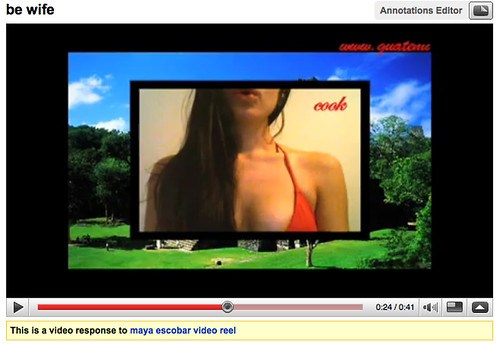
In October of 2006 my rabbi started blogging. While trying to comment on one of his posts, I accidentally registered my own blog. Within hours of posting a comment, my name began appearing in Google searches. I was now linked to the post I had commented on, previous posts my rabbi had written, comments left by other users and the posts they had written elsewhere within the blogosphere. The rapidity with which I was branded, not only by my own online activity, but also by the online activity of others, seemed incomprehensible.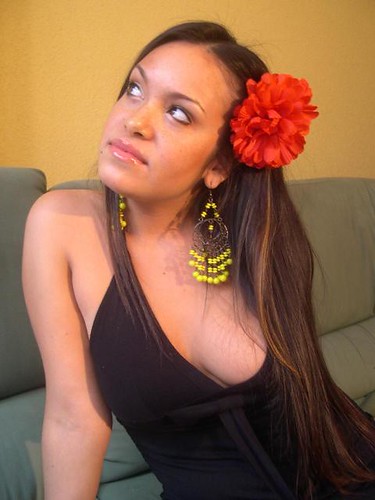 I thought about this phenomenon in relationship to, the images that my friends and I had posted on Myspace throughout that year. I unknowingly went from being slightly annoyed and simultaneously amused by the phrase "take a picture of me for my Myspace", to it becoming completely natural and almost organic to document every moment, every outing, every time my friends and I put on make up, and to take pictures for Myspace. I saw this behavior even further exaggerated in the high school students I was student teaching. Their conversations were dominated with events that had transpired on Myspace, and when they were not talking about Myspace they were taking pictures for Myspace.When we talked about the factors that contributed to the construction of their individual and collective identities, my students were quick to bring up their style of dress, group of friends, the neighborhood they lived in, and the way they spoke. Yet not a single student referenced their online activity, the pictures they posted, the groups they joined, the comments they left on each others pages. I wondered why it was, that they were so aware of and adept at reflecting upon their experiences in the material offline world, but failed to mention the social network that played such a major role in their day-to-day lives.DECONSTRUCTING PERSONAL IDENTITY
I thought about this phenomenon in relationship to, the images that my friends and I had posted on Myspace throughout that year. I unknowingly went from being slightly annoyed and simultaneously amused by the phrase "take a picture of me for my Myspace", to it becoming completely natural and almost organic to document every moment, every outing, every time my friends and I put on make up, and to take pictures for Myspace. I saw this behavior even further exaggerated in the high school students I was student teaching. Their conversations were dominated with events that had transpired on Myspace, and when they were not talking about Myspace they were taking pictures for Myspace.When we talked about the factors that contributed to the construction of their individual and collective identities, my students were quick to bring up their style of dress, group of friends, the neighborhood they lived in, and the way they spoke. Yet not a single student referenced their online activity, the pictures they posted, the groups they joined, the comments they left on each others pages. I wondered why it was, that they were so aware of and adept at reflecting upon their experiences in the material offline world, but failed to mention the social network that played such a major role in their day-to-day lives.DECONSTRUCTING PERSONAL IDENTITY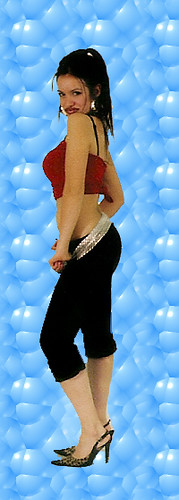 (today) I am referring to myself as a performance artist, Internet curator, and editor. I create and (concurrently) perform multiple online identities, by sampling from different representations of existing cultural discourses. I fragment my personal experiences and invite others to join in, and modify and regroup those fragments. By doing this I hope to share the process through which I deconstruct and reconstruct my individual conception of self, so that others can do the same in their lives.In the series Acciones Plásticas I performed representations of five constructed characters: a religious Jewish woman, a spoiled Jewish girl, a ghetto Latina, a sexy Latina professor, and a Mayan woman. I created low quality YouTube video blogs for four of the characters, the Mayan woman did not have a video, as she would not have had access to YouTube technologies. The videos were strategically placed on popular social networking sites, including YouTube and MySpace. The layout of YouTube contextualized the videos and framed them with user comments and similarly tagged user content. Jewish Girls was picked up by a popular left-wing Jewish blogging site Jewschool, and soon entered the Jewish Blogosphere where it was referred to as the JAP. This repositioning shifted the focus from the portrayal of multiple interwoven identities to a depiction of the Jewish American Princess. The JAP became how people knew my work, validating me while simultaneously conflating my identity with that of this particular character.
(today) I am referring to myself as a performance artist, Internet curator, and editor. I create and (concurrently) perform multiple online identities, by sampling from different representations of existing cultural discourses. I fragment my personal experiences and invite others to join in, and modify and regroup those fragments. By doing this I hope to share the process through which I deconstruct and reconstruct my individual conception of self, so that others can do the same in their lives.In the series Acciones Plásticas I performed representations of five constructed characters: a religious Jewish woman, a spoiled Jewish girl, a ghetto Latina, a sexy Latina professor, and a Mayan woman. I created low quality YouTube video blogs for four of the characters, the Mayan woman did not have a video, as she would not have had access to YouTube technologies. The videos were strategically placed on popular social networking sites, including YouTube and MySpace. The layout of YouTube contextualized the videos and framed them with user comments and similarly tagged user content. Jewish Girls was picked up by a popular left-wing Jewish blogging site Jewschool, and soon entered the Jewish Blogosphere where it was referred to as the JAP. This repositioning shifted the focus from the portrayal of multiple interwoven identities to a depiction of the Jewish American Princess. The JAP became how people knew my work, validating me while simultaneously conflating my identity with that of this particular character.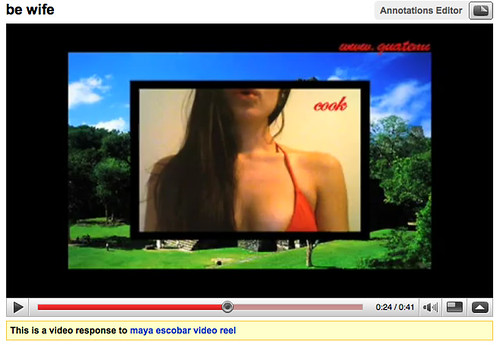 One of the strategies that I employed to counteract idea of "me as The JAP" was to group videos from the series Acciones Plásticas together with three other Youtube videos in a video reel of my work. The first video in the reel, el es frida kahlo is me dressed as Frida Kahlo where I violently scream I am Frida Kahlo! In second video Be Wife, I wear a bright red bikini top in front of an image of a Mayan temple in Tikal. Traditional Guatemalan marimba music plays in the background, while red text scrolls across the top reading Guatemala's finest export. The third video Que Sencilla, features me as a little girl, who is being coaxed by an off-camera male voice to perform a dance for the camera.Someone who is expecting to see a Jewish American Princess, is instead greeted with an enraged
One of the strategies that I employed to counteract idea of "me as The JAP" was to group videos from the series Acciones Plásticas together with three other Youtube videos in a video reel of my work. The first video in the reel, el es frida kahlo is me dressed as Frida Kahlo where I violently scream I am Frida Kahlo! In second video Be Wife, I wear a bright red bikini top in front of an image of a Mayan temple in Tikal. Traditional Guatemalan marimba music plays in the background, while red text scrolls across the top reading Guatemala's finest export. The third video Que Sencilla, features me as a little girl, who is being coaxed by an off-camera male voice to perform a dance for the camera.Someone who is expecting to see a Jewish American Princess, is instead greeted with an enraged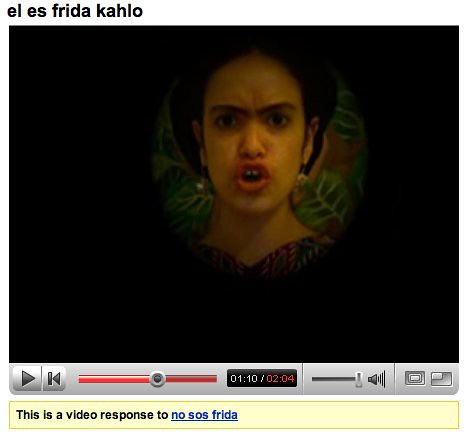 Latina artist, trying to fight the stigma of being associated with Frida Kahlo. My inclusion of these additional videos was to show the multidimensionality of the five characters initially presented in Acciones Plásticas. The Mayan women does not have her own YouTube video, but with the addition of the Be Wife video, her absence is felt even greater. The face of Guatemala in these videos, is the chest of a mail order bride. Another example can be seen within the four original videos themselves. With the grouping of the ghetto latina with the sexy latina professor, vast cultural and class difference can be seen between the two representations of Latina women. Put together with el es frida kahlo and Be Wife, there are suddenly five Latina performers all acting on one stage.
Latina artist, trying to fight the stigma of being associated with Frida Kahlo. My inclusion of these additional videos was to show the multidimensionality of the five characters initially presented in Acciones Plásticas. The Mayan women does not have her own YouTube video, but with the addition of the Be Wife video, her absence is felt even greater. The face of Guatemala in these videos, is the chest of a mail order bride. Another example can be seen within the four original videos themselves. With the grouping of the ghetto latina with the sexy latina professor, vast cultural and class difference can be seen between the two representations of Latina women. Put together with el es frida kahlo and Be Wife, there are suddenly five Latina performers all acting on one stage.
[youtube=http://www.youtube.com/watch?v=bGjJhIFUNGA][youtube=http://www.youtube.com/watch?v=CycyYiY933A][youtube=http://www.youtube.com/watch?v=yCM4rrhbj5U]click here to visit website
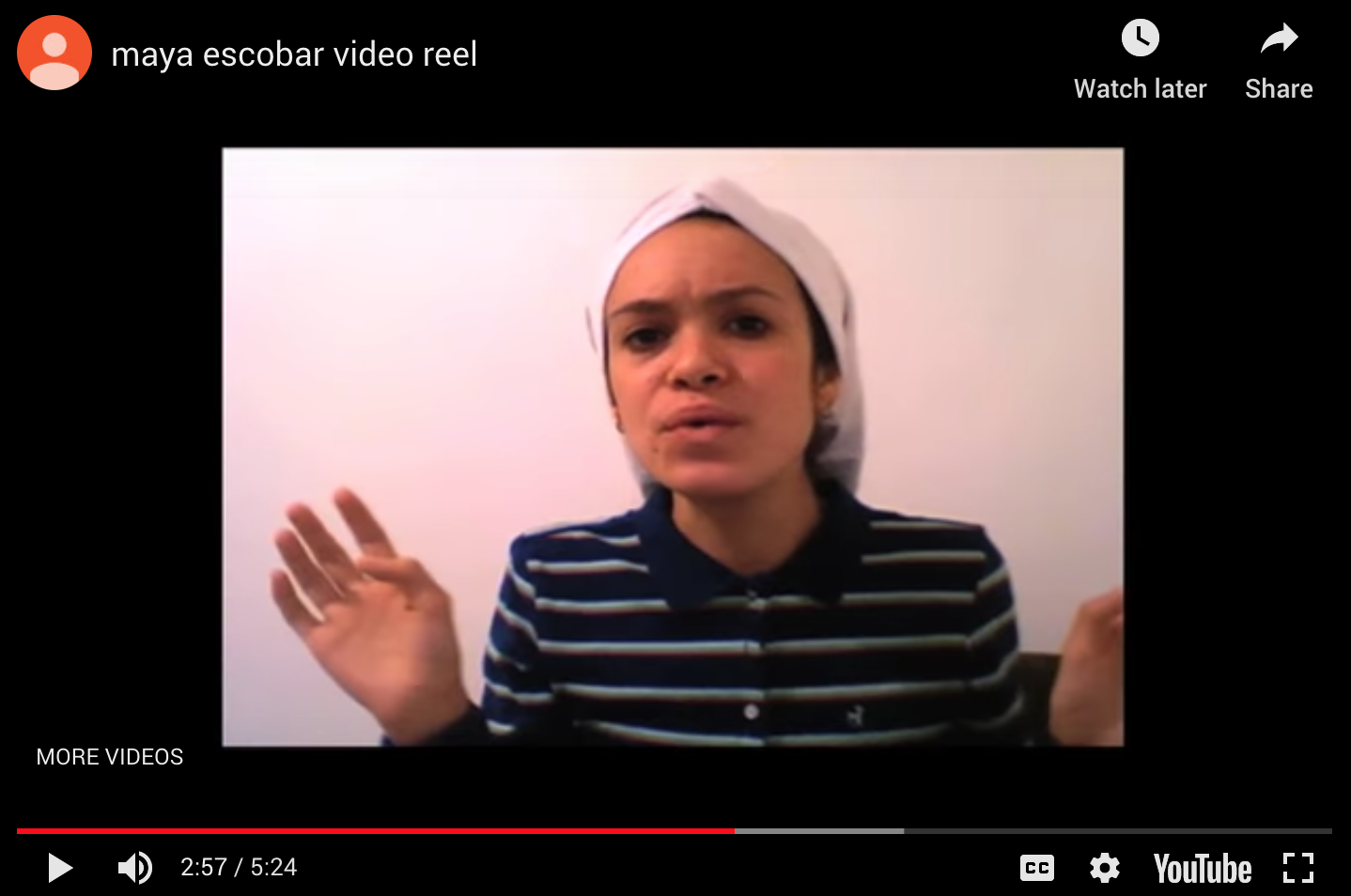
Frida Kahlo at the synagogue: Maya Escobar and the young Jewish-American Creationby David Sperber in Ma'arav Israeli Arts and Culture Magazine.translation by Shlomit NehoraiARTICLE IN SPANISH & HEBREWMaya Escobar is no doubt one of the 'hottest' things developing in the Jewish-American art scene. Escobar defines herself "dyslexic internet artist". And in order to view her work you need not wander far.Her work is mostly created in familiar internet format, and is most often displayed on Youtube. Escobar, daughter to a Jewish mother and Guatemalan father, defines her art work as ongoing personal anthropological-sociological research into the narrative language that uses contemporary media.[youtube=http://www.youtube.com/watch?v=3li_mT--f-A]The "Acciones Plasticas" work includes short films that present a series of convincing characters and monologues that deal with identity questions. In the first short film in the series she appears dressed up as the Mexican artist Frida Kahlo who became an icon within the feminist discourse. it is commonly argued that Kahlo had some Jewish roots. Escobar is dressed and made up as is famously attributed to Kahlo - the uni brow - while screaming "I am Frida Kahlo, you are Frida Kahlo, we are Frida Kahlo". In agitation or in ecstasy she tears her custom, messes up her hair, wipes her make up off of her face and returns to being herself. In another short film in the series she carries on with a monologue of a jewish orthodox woman. The text here is so exact that for a minute the line between irony and slapstick to deep seriousness is blurred. In another short film the stereotypical Latin female as a sexual sensual object is presented, when here too the subject is moving between embracing the stereotypes and breaking them. Escobar is presenting different episodes that she had experienced herself and that deal with her hybrid identity as a woman, as a Jew and as a Latin American.[youtube=http://www.youtube.com/watch?v=NNAxEUEE43Y]
Another work of Escobar is "my shtreimel" - a video-blog that is also presented on Youtube.In that piece appears a young man in his twentieths who sits in his room in front of a computer and talk about his Shabbat rituals. The monologue describes an amorphous jewish world in which jewishness lives and materializes without obligation to its institutions and mostly in personal frameworks. A central part in this world is self deprecation: The young man shows his beloved shtreimel and mentions that the shtreimel which looks like the traditional is actually a women's hat purchased at a thrift store.
In the work "eruv" (intermingling) Escobar relates to the fact that in Berlin there is no eruv even though there exists a vibrant jewish community. In a series of photographed interviews with the city's citizens she transforms the notion eruv - from a halachic-legal notion that creates a conversion of the public space into the private space, into a blending - the creation of a multiple of characters and worlds. The blending (eruv)transforms into a cultural concept that celebrates the different and the unique. The individuals create a splendid mosaic that assembles anew the "collective" as a social concept. The way Escobar deals with the subject is typical to the jewish-american art world that tends to transfer concepts from the practical halachic and transfer them to another world, and so they transform into a metaphor of the personal or social condition. The personal experience is significant to Escobar: " Like other jewish rituals, the Shabbat encompasses practicalities that materialize private condition in a private space. Except that the understanding of the private space and the public space is fluid and changes at all times. I think that it is very important that people celebrate their Shabbat as a pleasant experience, defined and personal. The Shabbat rituals evolve all the time - not as an unbending obligation that is transferred from generation to generation, but as a result of a simple choice of the individual to create to him/herself nice and pleasant Shabbat customs. We all have these kind of customs."The intercontinental use of the Internet gave birth to a generation of individuals who create for creation's sake, and the concept of art for art's sake gets that way a new meaning. The Internet media connects individuals and contributes to mutual influences between people who work separately in far away places. The young work on the Internet challenges the old definitions in relation to what is considered art and what isn't. Similarly, it adopts new presentation forms that are not the norm in the art world's mainstream, and breathes new air into the art field.The discussion into Escobar's work leads into a wider discussion about the differences between the Jewish thinking in the Israeli discourse into the new understanding of the American world view. The Jewish-artistic engagement in the United States is influenced by the introduction of new-age ideas into the center of the conversation, and is integrating into the effort to create a connection between contemporary culture and the traditional Jewish identity. Within the American-Jewish community there are signs of a move from an organized institutional Jewish expression into a unique and personal expression of the very personal experience. These artists reorganizing the traditions on their own terms, and in this way contributing not insignificantly to the definition of Jewish-American Non-Orthodox Modern-orthodox anew. The link between Jewish culture and Jewish identity to art occupies a central role in this conversation.The echoes of this tendency can be seen in Israel as well ( in the young Yiddish culture developing in Tel Aviv, for instance ), but generally there is still a deep disconnect between the dominant concepts in Israel and in the United States. In Israel it is common to connect between Judaism to an organized tradition and to a blood line that is based on a genetic continuity. On the other hand, many young Jewish-Americans marry outside their religion, but nevertheless see themselves as an integral part of the Jewish world and expect to not be expelled from it. As opposed to Israelis who experience their Jewishness in terms of disintegration that followed restoration, the Jewish-Americans create new branches where growth and rebirth metaphors fit them better.The joining of contemporary culture and art to Jewish creativity expresses itself in fashionable characteristics like tattoos, hip-hop music, Internet art and the like, and is often understood as the disconnect with the accepted binary dichotomy between holly and the common. That is why conservative bodies see these art forms as a dangerous provocation. These new cultural concepts interconnect during confrontational discussions with the old cultural concepts. Philologically speaking it can be said that borrowing symbols from one discipline to another interferes with the semiotic systems. In the Kabalistic vernacular it is said that the energy that is released during the friction that is created by the disintegration of the usual vessels - creates "new light".
Ruth at the writing center (who somehow amazingly manages my artistic craziness and dyslexia) helped me come up with this metaphor for my work, based on the story of the elephant and the blind men.I think it might become my artist statement.
Some people think that I am the true representation of the elephant.It is true I am an elephant, but not the only elephant.I try to break up the conception of being the only elephant.Some people see a small portion of my work and think it is the whole- the representative elephant.Others understand that each piece connects to another piece and that individually they are only fragments.When breaking the elephant up into pieces, information slips in through the cracks.People also respond to this new information- creating a bigger more amorphous elephant.
The amorphous elephant is broken up again and again, so that it is relevant to new individuals new experiences...
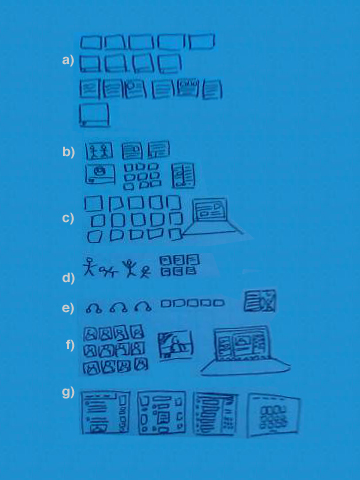 a) accionesplasticas.comb) mayatalk.wordpress.com/2007/04/11/obsessed-with-frida-kahlo/c) thewayismadebywalking.com/d) www.youtube.com/watch?v=V5sFV2xmpfAe) berlinseruv.comf) www.youtube.com/watch?v=359HwupsY1sg) mayaescobar.com
a) accionesplasticas.comb) mayatalk.wordpress.com/2007/04/11/obsessed-with-frida-kahlo/c) thewayismadebywalking.com/d) www.youtube.com/watch?v=V5sFV2xmpfAe) berlinseruv.comf) www.youtube.com/watch?v=359HwupsY1sg) mayaescobar.com
Part 1 of an article I wrote for jewishinstlouis.orgEvery art student learns about the fair use principle, granting us permission to use any image in our artwork as long as we transform it so that it conveys new meaning. But beyond that all-encompassing definition, we don’t know what transgressions, if any, we are actually committing. Recently in the news is the preemptive lawsuit artist Shepard Fairey filed against the Associated Press. According to Fairey the AP threatened to sue him unless he pays royalties for the image that he used as source material for his now famous campaign poster of Barack Obama. Fairey argues that he is protected by the fair use principle. He claims that his intention was not to reproduce any particular image, but instead was to capture a specific gaze representative of the ideas of hope and change.In an interview on NPR, Fairey declared he was going forward with this suit on behalf of all artists, the thousands of artists that created their own campaign images in the same grassroots manner, pulling images from the web in support of the message of hope, change and a new administration in Washington.
Recently in the news is the preemptive lawsuit artist Shepard Fairey filed against the Associated Press. According to Fairey the AP threatened to sue him unless he pays royalties for the image that he used as source material for his now famous campaign poster of Barack Obama. Fairey argues that he is protected by the fair use principle. He claims that his intention was not to reproduce any particular image, but instead was to capture a specific gaze representative of the ideas of hope and change.In an interview on NPR, Fairey declared he was going forward with this suit on behalf of all artists, the thousands of artists that created their own campaign images in the same grassroots manner, pulling images from the web in support of the message of hope, change and a new administration in Washington.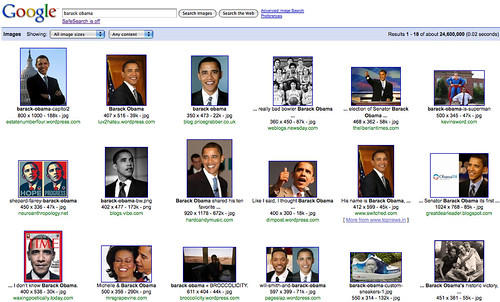
I am fascinated by Fairey’s implication that the process of appropriating and re-contextualizing Google image search results might be considered a grassroots action. As an artist, I frequently use images that that I find on Google. Like Fairey suggested, my motivation for using these images is to highlight the search itself, not the derivative image.Perhaps then, these cyber Robin Hoodian actions—using and transforming Google image search results—are capable of changing the structures that control the dissemination of information. After all, the order that information appears in Google searches is determined by the amount of people searching any given topic. And as a result of the Fairey’s appropriation, his campaign poster may be forever linked to Obama’s presidency.
Obama’s popularity can be credited to his skillfully constructed presidential campaign that effortlessly linked his name to hope. I was quick to jump onto Obama’s online campaign message of hope. Like many others, I subscribed to his twitter, facebook, and YouTube pages. I now get weekly emails from him and I even have a blog on his site…
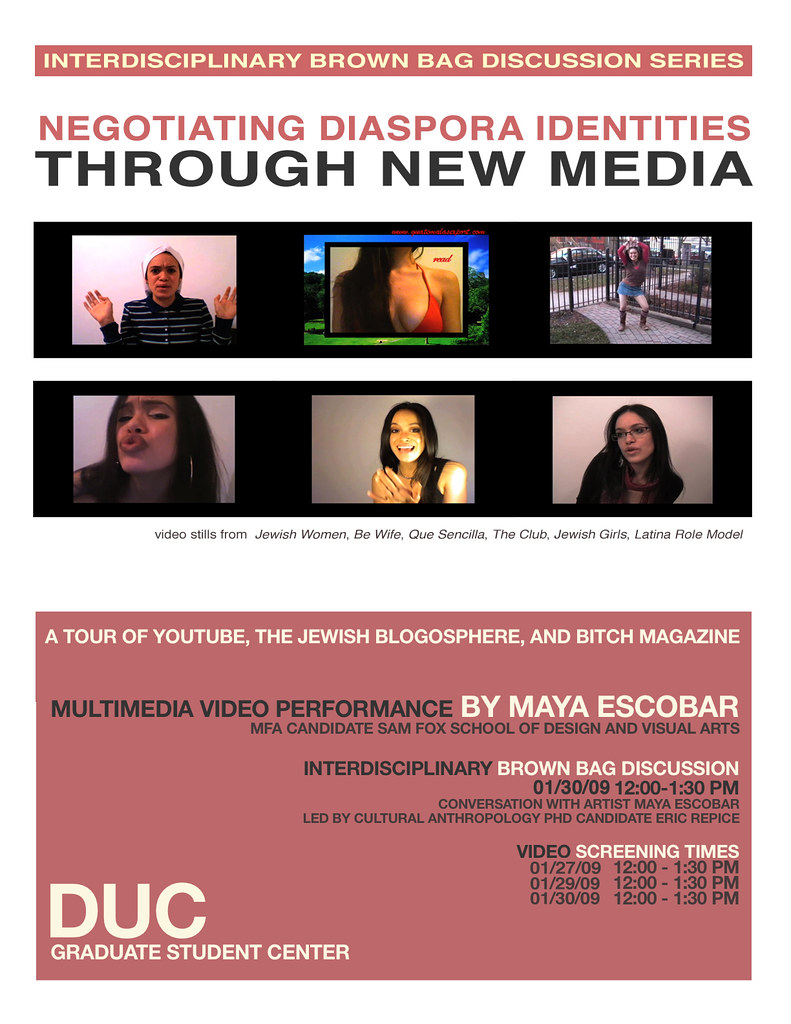 Join PhD Anthropology Candidate Eric Repice and MFA Candidate Maya Escobar in a brown bag lunch discussion concerning transnational, transcultural, and hybrid negotiations of identity through new media.How do these discussions vary between our fields?
Join PhD Anthropology Candidate Eric Repice and MFA Candidate Maya Escobar in a brown bag lunch discussion concerning transnational, transcultural, and hybrid negotiations of identity through new media.How do these discussions vary between our fields? Eric Repicefor more information on Eric Repice visit http://www.artsci.wustl.edu/~esrepice/homefor more information on Maya Escobar visit http://mayaescobar.com[youtube=http://www.youtube.com/watch?v=3li_mT--f-A][youtube=http://www.youtube.com/watch?v=G-GDmDcSH4g][youtube=http://www.youtube.com/watch?v=whLYM9o946w][youtube=http://www.youtube.com/watch?v=Vz2fhmRzCOA][youtube=http://www.youtube.com/watch?v=14bv0-dzMIc][youtube=http://www.youtube.com/watch?v=NNAxEUEE43Y]
Eric Repicefor more information on Eric Repice visit http://www.artsci.wustl.edu/~esrepice/homefor more information on Maya Escobar visit http://mayaescobar.com[youtube=http://www.youtube.com/watch?v=3li_mT--f-A][youtube=http://www.youtube.com/watch?v=G-GDmDcSH4g][youtube=http://www.youtube.com/watch?v=whLYM9o946w][youtube=http://www.youtube.com/watch?v=Vz2fhmRzCOA][youtube=http://www.youtube.com/watch?v=14bv0-dzMIc][youtube=http://www.youtube.com/watch?v=NNAxEUEE43Y]
UPDATE: PHOTOS
 On an almost daily basis, I receive emails from people asking if I am in fact actually Jewish. Although I do find it somewhat bizarre that they find satisfaction in my acknowledgment of what I have already stated numerous times, I usually respond. Come to think of it, the occasions where I have been accepted as a Jew (without further questioning) have been few and far between.
On an almost daily basis, I receive emails from people asking if I am in fact actually Jewish. Although I do find it somewhat bizarre that they find satisfaction in my acknowledgment of what I have already stated numerous times, I usually respond. Come to think of it, the occasions where I have been accepted as a Jew (without further questioning) have been few and far between.
Recently I discovered that without our knowledge, the validity of my own and my brother Gonzalo’s Jewishness has come into question (to the point where documentation has been requested) from people that we are now very close with.Below are some of the examples of comments (not emails, I do not share the content of emails without permission) from youtube:
roundedwhtcollar Am I the only one who thinks this reprobate Turd is NOT in fact a Jew? Rafaelpicc But is her las name jewish? or converted? ReptorY her last name isnt jewish. xruchy you are not jewish i guess... tus videos= cero aporte raquelita40 she's half Jewish/ half Guatemalan.nakedjanet marked as spam i am also suspicious. for one thing, escobar is not a typical Jewish name. For another, Jewish girls are usually a whole lot smarter, and have a whole lot more substance, than this girl has
(from chaptzem blogspot) There is no way she is Jewish- there may be a small chance her family are anusim or something.But what gets even more bizarre is that interspersed with in those comments are horrible anti-semitic statements:
johnnycastle86xx all the jews have to die, stupid jewish puta de mierda. Que mierda que Hitler no mato a tu familia, asi tu no hubieras nacido. muerte a los judios y muerte a israel. mocrostyle3600 AnotherJewish nasty bitchmrrimfire She's an ugly cockroachfilet there's a nice Jewishcrew- club... Its re-open and called Auschwitz. the drinks are on the house!!! but only for jewish people roshanpinto13 i want to put you in a concentration camp bitch if your people want israel so bad why don’t you go there and rid the world from your hideous jewish ways
So in light of my sarcasric sense of humor I entitled this post : Maya Escobar isn’t even Jewish I wonder what will come of that statement... From Judaism 101: Who Is a Jew?
First, traditional Judaism maintains that a person is a Jew if his mother is a Jew, regardless of who his father is. The liberal movements, on the other hand, consider a person to be Jewish if either of his parents was Jewish and the child was raised Jewish. Thus, if the child of a Jewish father and a Christian mother is raised Jewish, the child is a Jew according to the Reform movement, but not according to the Orthodox movement. On the other hand, if the child of a Christian father and a Jewish mother is not raised Jewish, the child is a Jew according to the Orthodox movement, but not according to the Reform movement! The matter becomes even more complicated, because the status of that children's children also comes into question.
In my case my mother is Jewish and my father is not. Yet it is my father that pushed me to go to Hebrew school until I was 16. Rain or shine my parents have been attending Shabbat services at JRC for almost 20 years. I remember being so mad as a child that my friends got to go out on Friday nights, and I was stuck with my family not even allowed to watch TV when we got home from services. Vickie Korey left the nicest comment on my Rabbi Brant Rosen’s blog:
I remember Maya at Friday night services at JRC, sometimes listening intently, sometimes reading, but always being present. When one of the children of our extended spiritual family grows to be such a fine, thoughtful and accomplished young woman we are all proud. Gonzolo and Tina have worked hard to set a strong foundation for Maya and I am so pleased for her and her family.
A few months ago I met with my Rabbi to discuss my (art) work. During our discussion I mentioned to him how my father is feeling really nervous about me having an orthodox wedding where he will not be included in the ceremony. Brant said something to me that really touched my heart. Your father is the essence of what a Jew is, he is a stranger in a strange land. I agree with him whole-heartedly, and if you ask most JRC members I am sure they would agree as well. However that does not change the fact that he is not considered to be Jewish by our neighbors, and even if he converted, to them it would not be halakhic unless he went through orthodox conversion. So who is a Jew? Who determines this?As I stated in a previous post I will be working as the art director this summer for Camp JRF. I am in the process of creating this summer’s curriculum that will be geared towards answering these very questions and challenging notions of Jewish Identity. Below is a very rough sketch of my plan…. (Please let me know if you have any suggestions, or would be interested in contributing any resources) The Changing Face of Jewish Identity: an exploration of self and what it means to be a Jew in our contemporary societyTo introduce the concept of a changing Jewish Identity will discuss the following:
Mediums Mixed media sculpture Art Exhibitions The Jewish Identity Project Too Jewish Challenging Tradition Identities Written Works by Ilan Stavans Achy Obejas Rebecca Walker Campers will produce mixed media sculptures that reflect their perception of what it means to be a JewPre- Activities:
Project Campers working in groups of 3-4 will have the option of creating either abstract or representational mixed media sculptures that to them represent Jewish identity. Prior to the construction of their piece students will need to create a (flexible) proposal that outlines their piece.
If they end up going with more representational sculptures I thought it would be really cool to photograph the sculptures and to place them in various Jewish settings and non-Jewish settings (baseball stadium, temple, Shabbat dinner, work, school....)